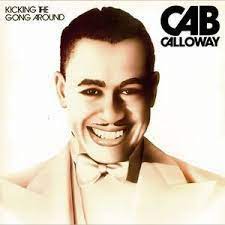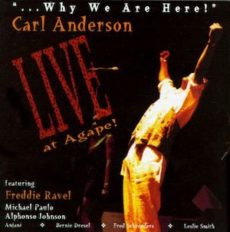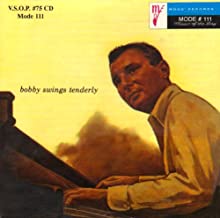
Daily Dose Of Jazz…
Cabell Calloway III was born on December 25, 1907 in Rochester, New York, on December 25, 1907 to two college graduates, his mother a teacher and church organist, and his father who worked as a lawyer and in real estate. The family moved to Baltimore, Maryland, in 1919 but soon after, his father died and his mother remarried.
Growing up in West Baltimore’s Druid Hill neighborhood Cab often skipped school to earn money by selling newspapers, shining shoes, and cooling down horses at the Pimlico racetrack where he developed an interest in racing and gambling on horse races. He ended up in Downingtown Industrial and Agricultural School, a Pennsylvania reform school run by his mother’s uncle.
Returning to Baltimore he resumed hustling, worked as a caterer while he improved his studies in school, and his mentors included drummer Chick Webb and pianist Johnny Jones. After graduating high school Calloway joined his older sister Blanche on tour for the popular black musical revue Plantation Days. He spent most of his nights in Chicago, Illinois clubs performing as a singer, drummer, master of ceremonies and as an understudy for singer Adelaide Hall. There he met and performed with Louis Armstrong, who taught him to sing in the scat style.
He established himself as a vocalist singing Ain’t Misbehavin’ by Fats Waller. The Thirties saw Cab’s orchestra permanently at the Cotton Club in Harlem, performed twice a week for radio broadcasts on NBC, and appeared on radio programs with Walter Winchell and Bing Crosby. He was the first Black American to have a nationally syndicated radio show and during the depths of the Great Depression he was earning $50,000 a year at 23 years old.
During the decade he recorded his most famous song, Minnie the Moocher, and became the first single record by a Black American to sell a million copies. He performed the song along with St. James Infirmary Blues and The Old Man of the Mountain, in Betty Boop cartoons of the same name.
His success with Minnie the Moocher and his relationship to the chorus earned him the nickname, The Hi De Ho Man. He performed a gliding backstep dance move called The Buzz, which some observers have described as the precursor to Michael Jackson’s moonwalk. He would go on to be featured in several films, and made his first Hollywood feature film appearance opposite Al Jolson in The Singing Kid in 1936.
His band included Ben Webster, Illinois Jacquet, Milt Hinton, Danny Barker, Doc Cheatham, Ed Swayze, Cozy Cole, Eddie Barefield, and Dizzy Gillespie. He entertained troops during World War II, hosted a weekly radio quiz show called The Cab Calloway Quizzicale and recorded songs full of social commentary. He appeared in the film Stormy Weather, one of the first mainstream Hollywood films with a black cast. Then he played the prominent role of Sportin’ Life in a stage production of Porgy and Bess. He continued to perform in movies and on stage throughout his career.
He published an autobiography and Cab Calloway’s Cat-ologue: A “Hepster’s” Dictionary, the first dictionary published by a Black American. It became the official jive language reference book of the New York Public Library.
Suffering a stroke at his home, vocalist, bandleader and actor Cab Calloway transitioned from pneumonia on November 18, 1994, at the age of 86, at a nursing home in Hockessin, Delaware.
More Posts: actor,bandleader,history,instrumental,jazz,music,vocal

Daily Dose Of Jazz…
Carl Anderson was born Carlton Earl Anderson on February 27, 1945 in Lynchburg, Virginia, one of 12 children to James and Alberta Anderson. During his junior year of high school, he enlisted in the U.S. Air Force, where he served as a communications technician for two years. Honorably discharged and returning home he completed high school, graduating in 1965. He went on to sing at military bases across the United States as part of the World Wide Air Force Talent Contest.
Making his way to Washington, D.C. in 1969, he and some friends formed a group called The Second Eagle with Anderson handling the vocals. They covered jazz and rock tunes that included songs from the album Jesus Christ Superstar, released long before the stage production was launched. In 1971, a talent agent from the William Morris Agency saw Anderson perform some songs from the show at St. Stephen’s Church and recognized his potential as a solo performer.
His global popularity and star power came from his role as Judas in Jesus Christ Superstar both on Broadway and in the film. He also had rolesin The Black Pearl, The Color Purple, The Eddie Capra Mysteries, Cop Rock, Days of Our Lives, and Hill Street Blues.
As a recording artist, Carl was equally prolific, initially signing with Motown Records in 1972, working with Stevie Wonder on his Songs in the Key of Life double album, as well as numerous others. While working the club circuit in Los Angeles, California he was noticed by and signed to Columbia Records and released four albums on their Epic label. He would go on to perform duets with Gloria Loring, Angie Bofill, Linda Eder and Nancy Wilson.
His duet with Loring, Friends and Lovers, reached Number 2 on the charts, and endeared Anderson to soap opera fans, after being performed on Days of Our Lives. He also recorded Between You and Me, as the title theme for the film Her Alibi.
In 2003 he had a minor car accident on his way to perform and while being treated for his injuries, doctors discovered that he had leukemia. Soul jazz vocalist and actor Carl Anderson passed away the following year from the illness on February 23, 2004, in Los Angeles, just four days before his 59th birthday.

Daily Dose Of Jazz…
Robert William Troup Jr. was born on October 18, 1918 in Harrisburg, Pennsylvania. Graduating from The Hill School in 1937, he went on to graduate Phi Beta Kappa from the Wharton School at the University of Pennsylvania with a degree in economics. His earliest musical success came in 1941 with the song Daddy and Sammy Kaye and His Orchestra recorded it sending it to #1 for eight weeks on the Billboard chart and #5 record of 1941.
After graduating from college in 1941, he enlisted in the United States Marine Corps, completed officer training, and was assigned to recruit the first Black Marines at Montford Point. While there, he organized the first Negro band of U.S. Marines. During this time he composed Take Me Away From Jacksonville, which became an anthem of sorts for the Marines at Montford Point and other areas of Camp Lejeune. In 1942, his song Snootie Little Cutie was recorded by Frank Sinatra and Connie Haines with the Tommy Dorsey Orchestra and the Pied Pipers.
In 1946, Nat King Cole had a hit with Troup’s most popular song, Route 66. Troup’s fifteen albums in the 1950s and 1960s were not commercially successful, recording for Liberty and Capitol. He composed the music for the instrumental version of his song The Meaning of the Blues that appeared on the Miles Davis album Miles Ahead.
While relying on songwriting royalties, Bobby worked as an actor, appearing in Bop Girl Goes Calypso, The High Cost of Loving, The Five Pennies, and playing musician Tommy Dorsey in the film The Gene Krupa Story. He also appeared on several television shows in the Sixties. It was during this time that he met Julie London, encouraged her to pursue her singing career, and in 1955 produced her million-selling hit record Cry Me a River. Four years later, London married Troup. On February 7, 1999, pianist, singer, songwriter and actor Bobby Troup passed away of a heart attack in the Los Angeles, California neighborhood of Sherman Oaks.
More Posts: actor,history,instrumental,jazz,music,piano,songwriter,vocal




